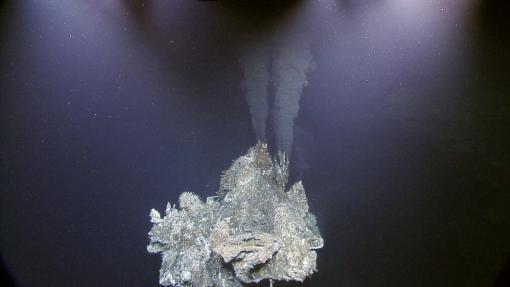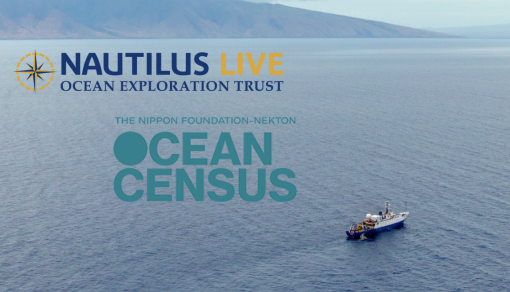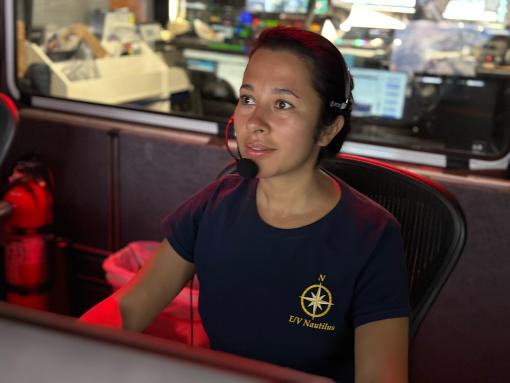The Important Connection Between Taxonomy and Exploration

The deep, dark ocean is teeming with life – much of which has yet to be discovered. There are an estimated one to two million marine species, but between 75%-90% remain undiscovered - and at the current rate (~2,300 species named per year), it’s a very slow process.
The Ocean Exploration Trust (OET) is dedicated to exploring the ocean through our 68m exploration vessel (E/V) Nautilus. Biological exploration launched from Nautilus focuses on various deep-sea ecosystems, including deep water coral and sponge habitats, chemosynthetic vent and seep communities, abyssal plains, funneling continental margin canyons, the expansive midwater, and marine megafauna. Taxonomy is the practice and science of categorizing, classifying, describing, and naming Earth’s organisms. Identifying and categorizing existing and new species is important for scientists worldwide to understand better our global ocean and how to protect it.
While exploring never-before-seen areas of seafloor miles below the surface, OET collects biological samples to help inform many science and policy areas. This is especially important for difficult-to-visit ecosystems such as hydrothermal vents. For example, genetic analyses show connections between populations of fish or invertebrates, which indicate how well a species in an area might bounce back if disrupted. Isotope analysis of tissue indicates food web connections, such nutrients an organism receives from chemosynthetic vs photosynthetic sources.

Over the years, many new species and lineages have been discovered or determined through E/V Nautilus samples. For example, the true diversity of deep sea invertebrates known as squat lobsters is still poorly known since many species inhabit the largely unexplored deep sea. In early 2023, scientists published multiple studies on new species and evolutionary histories of various squat lobsters in the Pacific Ocean, thanks in part to their study of samples collected from ROV Hercules. One of the new species was named Munidopsis nautilus in honor of E/V Nautilus, which collected the only known sample of this species.
A wide variety of biological samples are collected by Nautilus, and different techniques are needed depending on the size and fragility of the specimen. We collect full or part of biological samples (including corals, sponges, and more) using manipulator arms or with a slurp or scoop tool. Additionally, push cores are used to collect sediment samples and the infauna living inside various layers of the sediment. After an expedition, these biological samples are shipped to a repository, the Harvard Museum of Comparative Zoology, so that any scientist can request the sample for more detailed analyses.
We also collect water samples for environmental DNA (eDNA) extraction by filtering the water through a fine filter paper to capture all the dispersed DNA. eDNA comprises small pieces of organismal DNA found within the environment, including shed skin cells, mucus, feces, or small pieces of tissue. This eDNA can show various organisms that live or pass through an area, even if they are not observed on camera in front of the ROVs during a dive. Research partners conduct analyses of eDNA to uncover coral, sponge, and fish species or seep and vent-related species that occupy areas of interest.
Besides updating taxonomic trees, the information we gather on species and their interactions can help us plan management and conservation strategies in the face of accelerating climate change. For example, analyses of coral skeletons, especially long-lived, multi-century-old species like bamboo corals, show past effects of climate and help predict how changing climate may affect the future environment. Coral and sediment analyses also help illustrate historic ocean conditions and track ocean acidification impacts in the deep sea. Information from eDNA samples can be especially important in Marine Protected Areas and areas with complex fish habitat, to show which species utilize these resources and priority habitats to effectively preserve healthy fish stocks healthy for fisheries and the environment.
In 2023, OET proudly announced a new partnership with The Nippon Foundation-Nekton ‘Ocean Census’ – the largest program in history dedicated to species discovery in the ocean.
With the shared goal of revealing new knowledge about the ocean and building global connections to the sea's mysteries, the partnership strengthens the future of ocean science and ocean exploration for marine conservation. Together, OET and Ocean Census will facilitate the discovery of new species from the deep sea - the largest habitat on Earth.

Ocean Census’s workflow allows us to make the most of samples collected during our ROV dives, image processing, and next-generation molecular techniques, from sample acquisition, progression through taxonomy and molecular analysis, curation of specimens, integration into public databases and training new generations of taxonomists. Ocean Census Scientist Raissa Hogan joins OET’s NA153 expedition to explore the waters within the Johnston Atoll Unit of the Pacific Remote Islands Marine National Monument.
“Understanding and using taxonomy is crucial if we want to access, comprehend, and safeguard marine ecosystems,” says Raissa Hogan, Ocean Census Scientist. “The OET and Ocean Census partnership is unique and pioneering, holding the potential to significantly enhance the feasibility and efficiency of marine biodiversity assessment. In the face of a changing planet, the need for a global network dedicated to the global ocean becomes increasingly urgent.”
Currently, the overall process of species description can span years or even decades, limiting our understanding of biodiversity in the marine environment. Often, resources are available for certain steps of the process but fall short for others. For instance, we might have access to conduct molecular work but lack the means to have expeditions to collect high-quality samples or even revisit museum collections using new technologies.

“The collaboration between Ocean Census and OET has given me this amazing opportunity to be a part of the Johnston Atoll expedition, where I can observe and acquire samples I haven't studied before,” says Hogan. “I have mostly been working with collections from the Northeast Atlantic, so this is my first time surveying the deep waters of the Pacific. The two deep-sea coral groups I have worked on (sea pens and black corals) have had records in this area, but we are still in the infancy of understanding their distribution and phylogeny. The knowledge and networking I’m gaining from being part of this cruise is unique, and I am excited for future discoveries.”
Hogan says her main motivation for focusing on taxonomy was to have accurate descriptions of the deep sea animals encountered on surveys.
“While my primary interest lay in comprehending the evolution and biogeography of deep-sea corals, our understanding of biodiversity and the specific species we were dealing with compelled me to delve into the realm of taxonomy,” she says. “This study completely transformed my perspective on how we can grasp evolution – from a broad scale of time and space down to intricate details within colony composition.”
The process of taxonomy entails assimilating integrative data and often involves multiple stages before we can successfully describe a new species or understand its placement within existing classifications.
“I view taxonomy, much like many sciences, as a field that demands love and curiosity. It necessitates an inquisitive mind, adept observational skills across varying scales, and a healthy dose of patience,” says Hogan. “Taxonomy stands as a discipline of its own, yet it serves as the primary foundation for a multitude of other subjects. If we aspire to fathom various aspects of biodiversity, ecology, evolution, distribution, species boundaries, taxonomy becomes indispensable.”

Deep Sea Biodiversity & Ancient Seamount Exploration near Johnston Atoll
In August 2023, we will return to the Central Pacific for 27 days of exploration within the Johnston Atoll Unit of the Pacific Remote Islands Marine National Monument (PRIMNM), starting and ending in Honolulu.



